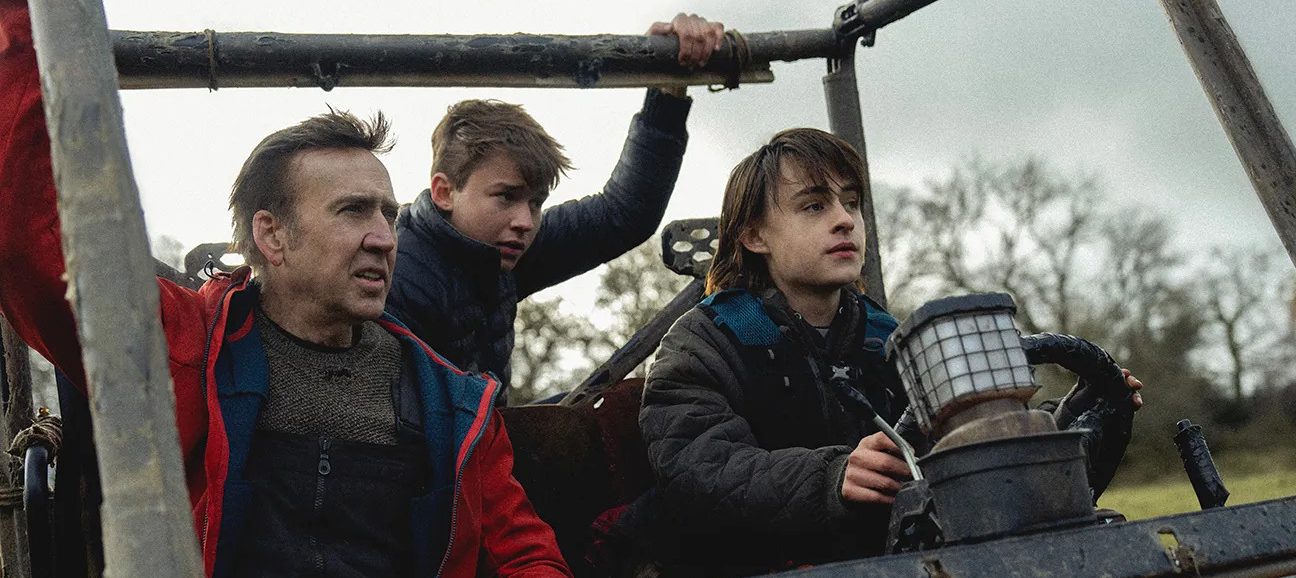Directed by Ben Brewer, ‘Arcadian’ is a post-apocalyptic horror thriller led by Nicolas Cage. He essays the character of Paul, the father of twin boys Joseph (Jaeden Martell) and Thomas (Maxwell Jenkins), who live in an isolated farmhouse. Times have changed, and humanity is facing extinction due to not just pollution but also the onslaught of ferocious creatures bent on killing humans.
What follows is how the trio protects itself from being killed while trying to live like a normal family. For a post-apocalyptic movie, world-building is essential, and computer-generated environments don’t do complete justice. The movie thrusts the viewers into a tense environment, ranging from deserted streets and water bodies to a farmhouse in the middle of an isolated location, which serves as a last resort for the lead characters.
Arcadian Filming Locations

‘Arcadian’ is shot primarily in and around Dublin, the capital of Ireland. A perfect amalgamation of past and present, the city serves as a symbol of nature at war. This thus adds to the underlying tone of the movie wherein Paul and his sons are in a constant fight with the creatures and the city’s current state. The actual locations help establish the contrast between the natural environment, and the scary surroundings in which the characters live. This gives the film its organic touch.
Under the working title ‘Sand and Stones,’ principal photography began on November 7, 2022, and the production carried on for several weeks before wrapping up in December of the same year. Instead of going all the way with the usage of VFX, the production team also resorted to actual locations that served as an ideal setting for the dystopian world we see in the film.
Dublin, Ireland
The cast and crew visited several sites across Ireland to shoot the movie. While a major portion of the filming occurred at various places in and around Dublin, the capital of the Republic of Ireland, the production team also utilized the facilities provided by a production studio. To be specific, they set up camp at Ardmore Studios at Herbert Road in Killarney, located in the coastal town of Bray in County Wicklow. The beautiful Irish terrain becomes the backdrop for the events in the film. The team moved from one site to another across the city to shoot the different exterior scenes that are used to establish the barren/abandoned nature of a post-apocalyptic world.
In an exclusive interview with Digg, actor Maxwell Jenkins, when asked about nightmares during the filming of the movie, stated, “…We were living in this kind of resort about two hours outside of Dublin, in the middle of the Irish forest, Wicklow County, which they call a garden of Ireland. So it’s super green and gray because it’s the Irish winter. So definitely the environment was spooky.”
In conversation with Cooke Optics, cinematographer Frank Mobilio dropped numerous insights pertaining to the production process. Describing the dynamism of the unpredictable Ireland weather and how it impacted the shoot, he explained, “We were hoping for a lot of overcast skies and fog. Daytime was only from about 8 am to 4 pm. The first day of the shoot was meant to be a sunrise, and we were met with an absolute torrential downpour when we arrived at 6 in the morning. a bad omen maybe, but from then on, things were actually quite mild and there was more sun than any of us had imagined, but it actually worked in favor of the story.”
The production team worked out the layout of the sets as days and nights are poles apart in the film. The art department and the visual effects department have worked closely to enhance the looks of the interiors based on the time of day or night, e.g., the position of windows for daytime and that of the fireplace, candles, and lamps, which have been used as both light sources and props, for nighttime. Regarding the lenses he used, Mobilio stated how the close focus helped him and his team to shoot in tight locations and sets built to withstand harsh weather conditions. Tight locations make things look up, close, and personal, almost like the viewers are with the characters. A lot of attention is also paid to the exterior setting and to add as much realism as possible to a day and night outdoors in a post-apocalyptic world.
In a scene toward the film’s beginning, Jenkins’ character Thomas is running through the woods, and the camera is following him. He jumps over something at one point, and the camera tilts to reveal a crevice. This is not style but substance as the crevice has a role to play later. Many shots like these add realism to a plot set in a fictional place with fictional creatures.
Dublin is the birthplace of authors like Oscar Wilde, Jonathan Swift, and James Joyce. Its Guinness beer is famous across the world. Many scenes of the film ‘Cocaine Bear’ were also shot in Dublin and Wicklow. ‘Sing Street,’ ‘Once,’ ‘Ordinary Decent Criminal,’ ‘My Left Foot,’ and ‘Educating Rita,’ were shot extensively in and around Dublin, especially its suburbs, in all their glory. However, ‘Arcadian’ turns the table by using the beautiful place to show a planet facing extinction. As far as Dublin’s attractions are concerned, the Irish capital boasts the 13th century Dublin Castle, Dublin’s largest garden square St. Stephen’s Green, The National Museum of Ireland, Grafton Street, and Trinity College.
Read More: Best Post-Apocalyptic Movies on Netflix


You must be logged in to post a comment.